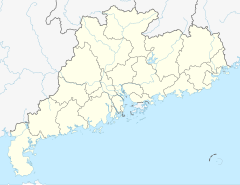| Renshou Temple | |
|---|---|
| 仁寿寺 | |
 Entrance of Renshou Temple. Entrance of Renshou Temple. | |
| Religion | |
| Affiliation | Buddhism |
| Sect | Chan Buddhism |
| District | Chancheng District |
| Prefecture | Foshan |
| Province | Guangdong |
| Location | |
| Country | China |
  | |
| Prefecture | Foshan |
| Geographic coordinates | 23°02′21″N 113°07′11″E / 23.03917°N 113.11972°E / 23.03917; 113.11972 |
| Architecture | |
| Founder | Master Zongtang |
| Date established | 1656 |
Renshou Temple (simplified Chinese: 仁寿寺; traditional Chinese: 仁壽寺; pinyin: Rénshòu Sì) is a Buddhist temple situated in downtown Foshan, Guangdong, China.
History

Renshou Temple was first built in the 13th year of Period Shunzhi (1656) in the Qing dynasty (1646–1911) by Chan master Zongtang (Chinese: 纵堂). In the 8th year of the age of Kangxi of Kangxi Emperor, namely AD 1669, monk Yulin (Chinese: 玉琳) rebuilt the shanmen. In the 1st year of Period Xianfeng (1851), monk Renji (Chinese: 仁机) reconstruction the temple.
In 1935, Li Peixian (Chinese: 李佩弦), a Chinese Tantric monk, donated property to establish the Ruyi Pagoda (Chinese: 如意宝塔), whose canonization ceremony was held by Venerable Master Hsu Yun in 1938.
In 1952, it was taken as a granary by the newly founded Communist government. After the Cultural Revolution in 1982, Xu Yeping (Chinese: 许业萍) and other lay Buddhists donated money to rebuild the temple. Shi Dashan (Chinese: 释达善) was invited to serve as its abbot. On June 29, 1998, Renshou temple was officially opened to the public.
Architecture
Now the existing main buildings include the Shanmen, the Mahavira Hall and the Ruyi Pagoda. Ruyi Pagoda is a seven story octagonal pagoda which was inlaid with Tibetan tablets and plaques. There are more than ten porcelain Buddha statues inside the pagoda.
List of abbot
- Zongtang (Chinese: 纵堂)
- Yulin (Chinese: 玉琳)
- Zhiyuan (Chinese: 祗园)
- Ciyun (Chinese: 慈云)
- Shi Dashan (Chinese: 释达善)
- Shi Mingsheng (Chinese: 释明生)
References
- ^ Huang Biyun (2015-02-13). 仁寿寺工程进展顺利 新大雄宝殿今年开建. leju.com (in Chinese).
- ^ 仁寿寺改造提升项目顺利 新大雄宝殿今年开建. FSonline (in Chinese). 2015-02-13.